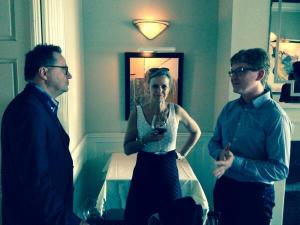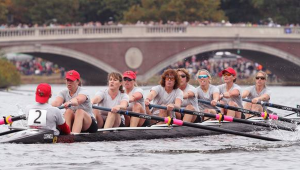5 ? with Kate Ackerman #RowingDoc #FemaleAthlete15
May 22, 2015 1 Comment
The 2015 meeting of the American College of Sports Medicine begins in less than a week, and I–like thousands of my colleagues–am getting ready: getting ready for the conference, getting ready for some blogging and tweeting coming to you from San Diego.
I am looking forward to seeing so many friends in the world of sports medicine: Avery Faigenbaum, Jon Patricios (with whom I’m giving a talk on ‘social media in sports medicine’), Tim Hewett….and Kate Ackerman.
Kathryn Ackerman, M.D., M.P.H. is a friend of mine whom I first met as she was wrapping up her training with Dr. Lyle Micheli, and I was beginning mine. She is an internist, fellowship trained in endocrinology as well as sports medicine. She is the Medical Director of the Female Athlete Program at Boston Children’s Hospital, the Associate Director of the Sports Endocrine Research Lab at Massachusetts General Hospital, a team physician for US Rowing, and an accomplished rower herself. A renaissance woman.

Dr. Margo Mountjoy (C); Former Editor in Chief of CJSM, Dr. Gordon Matheson (L); and Current Editor in Chief of CJSM Dr. Chris Hughes (R)
She is also the director of an upcoming conference on the “Female Athlete: Strategies for Optimal Health and Performance”, taking place June 19 – 20 2015 in Boston. Among the people speaking there are Margo Mountjoy, an internationally recognized expert on the Female Athlete who is also on our Editorial Board.
I just happen to be collaborating on a paper about dance medicine with other colleagues, and the section I am authoring deals in part with some of the issues to be addressed in the Boston conference. So it was perfect timing for me to catch up with Kate and ask her about her thoughts on the Female Athlete Triad, ‘Relative Energy Deficiency in Sport,’ and more.
Dr. Ackerman!
_____________________________________________
1) CJSM: Tell us about the upcoming Female Athlete Conference? What are some of the ‘Strategies for Optimal Health and Performance’ you will be discussing in Boston June 19 – 20?
KA: I’m really excited about this conference. We came up with the idea a few years ago, seeing a need to get good information out to athletes, parents, coaches, and the health providers who treat female athletes. There really wasn’t anything like this out there- a large conference devoted just to the multiple issues of the female athlete. So, we held the first 2-day female athlete conference two years ago, and we’ve decided to make it a biennial event. I think it’s a great opportunity to get some great minds together and I’m thrilled that so many people from different parts of the globe have agreed to come speak. The wealth of information is going to be fantastic and we make sure to provide lots of opportunities to network and mingle. We have some Brits coming to talk about biomarkers to monitor in endurance female athletes; Swiss Nanna Meyer discussing her experiences applying her sports nutrition research to the diets of US and Swiss Olympians; sports biomechanist Greg Myer speaking about ACL injury prevention; seasoned athletic trainers discussing good training plans for the growing female athlete; eating disorder experts discussing body image and unique issues of female athletes suffering from distorted eating patterns; coaches discussing personality profiling to get the best out of individuals and teams; members of the IOC Medical Commission’s female athlete group discussing RED-S; doctors discussing various sports injury treatments; and star power from Olympic gymnast Aly Raisman and the first woman to enter and win the Boston Marathon, Kathrine Switzer, who has been a great advocate for this conference and women participating in lifelong sports.
2) CJSM: We’re familiar with the concept of the “female athlete triad (Triad).” Newer terminology, “relative energy deficiency in sport (RED-S)”, is something we’re less familiar with. How are these entities related?
KA: The IOC was interested in 3 main things: 1) addressing other populations who could have health and performance consequences from underfueling, including males and adaptive athletes. 2) It wanted to broaden the focus to those other health and performance consequences, to remind athletes and others that underfueling has further effects than menstrual irregularity and bone loss. RED-S was a call to screen for issues relating to GI complaints, cardiovascular effects, immune dysfunction, performance decrements, etc. and to research these other areas more, to learn how significant they might be in different types of athletes. 3) Finally it wanted to develop a fairly simple screening tool for health providers to use to screen for RED-S, to get athletes plugged into treatment with a dietician, doctors, and other professionals as needed. Triad is an important topic that has focused predominantly on the menstrual and bone consequences of underfueling, and it is now a subset of RED-S according to the RED-S model. Whether we call in Triad or expand it to RED-S, the fact is, many athletes suffer from relative energy deficiency and the psychological and physical sequelae that accompany it. We need to expand awareness, treatment resources, and research to address this. Proceeds from the conference will go to some of this work, which is often difficult to fund.
3) CJSM: We understand you are quite an accomplished athlete—tell us about your rowing career. Are you still on The Charles at 5 a.m., or are you more likely to be on a Concept 2?
Unlike most athletes today, I began my main sport, rowing, in college. I was always an active kid, but much more involved in musical theater and recreational sports until I decided to try something different at Cornell. I was horrible at first, but fell in love with rowing and became pretty good. After college I took up sculling and eventually made the US Rowing team in the first lightweight women’s quadruple sculls. I competed in France, Canada, Croatia, throughout the US, and became a national champion a few times. I owe so much to the sport. I met my husband through rowing at our first Senior World Championships. He went much further than I, becoming a World Champion and Olympic spare, and we were both so caught up in our athletic and professional careers that we didn’t even start dating till almost 10 years later. Rowing is in our blood and we both still like it, but we’re driven people with 2 young kids, so we take turns fitting things in. I personally have a date every Friday morning with 3 fellow mommy rowers. We get our butts out of bed and shove off the dock at 5am. We have 9 kids and counting (another on the way) in that “Mommy Quad” and those Friday mornings are precious to us. The other days I try to find time for my single scull, running, biking, or lifting. I limit the Concept 2 to our home gym in the winter. I used to actually love that machine, because I was good at it, but as you get older, those numbers don’t lie, it hurts more, and I’m never as fast as I used to be or as I am in my own mind!
4) CJSM: You have to write a 140 character tweet to profile the upcoming conference: what would it say?
KA: I refuse to tweet. OK, for you Jim…
‘Don’t miss the Female Athlete Conference. Great minds from around the world collaborating to improve health & performance! #FemaleAthlete15‘
That’s 139. Not bad for a novice.
(CJSM: #GreatJob #NaturalTweeter #YouHaveAFuture)
5) CJSM: You’re heading to ACSM in San Diego, correct? Will you be speaking there? What are some of the things you are looking forward to at the conference?
KA: I really love the ACSM meeting. I’ll be going to the Bone Interest Group meeting Wednesday night, seeing folks I’ve worked with on Triad and RED-S issues, having fun with former Boston Children’s Sports Medicine fellows, and especially going to sessions on issues I know little about. The ACSM Annual Meeting is such a great opportunity to learn from people of different disciplines and to expand your horizons. I’ll cheer on our trainees presenting some of our research in amenorrheic athletes, attend interesting case presentations, and on Saturday, Dr. Susan Carter, a fun OBGYN from CO, and I are speaking about doping, “Are Hormones Really Performance Enhancers?” Then I’ll hit my old stomping grounds and meet up with great friends from our US Olympic Training Center days in Chula Vista. Some are still in the area.
See ya soon, Jim! I’m working on dinner reservations!
____________________________________________
Kate Ackerman, MD MPH, FACSM is the Medical Director of the Female Athlete Program at Boston Children’s Hospital, the Associate Director of the Sports Endocrine Research Lab at Massachusetts General Hospital, a team physician for US Rowing, and the Director of the upcoming Female Athlete Conference. She obtained her undergrad degree from Cornell, graduated from Johns Hopkins Medical School and the Harvard School of Public Health, completed residency in Internal Medicine at the Hospital of the University of Pennsylvania, a Sports Fellowship at Boston Children’s, and an Endocrine Fellowship at Brigham and Women’s Hospital. She’s a former national team rower, a mom of 2 young girls, and has a great sporty, supportive husband.

Pingback: #ACSM2015 | Clinical Journal of Sport Medicine Blog